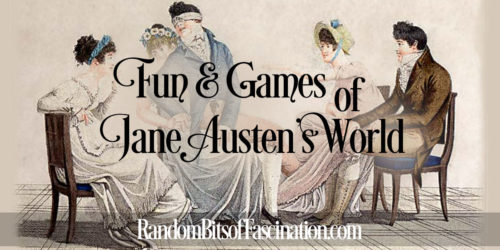Games of Jane Austen’s World: Pall Mall

Georgian gentry enjoyed outdoor games including pall mall. What was it and how was it played?
What did the gentlemen and ladies of the Regency Era do for fun? With the leisure time the gentry class enjoyed, pleasant pastimes were necessary–so without cable tv or streaming media, what did they do?
Often they played games. Card games are well documented, but outdoor games were enjoyed as well, among them, Pall Mall, a game thought to be an ancestor to modern croquet.

Pall Mall’s Long History
Pall Mall likely arrived in England around 1630 when John Bonnealle, a Frenchman, created a pall mall court on the south side of St. James’ square. In 1661, diarist Samuel Pepys mentioned going to St. James’s Park and watching the Duke of York Playing at Pelemele—apparently Pepys’s first exposure to the game. He described it as being played on a long, narrow court with iron hoops at either end.
A 1755 dictionary, written by Samuel Johnson, boasts a similar definition of “pall-mall.” So we believe the game continued to be played into the 18th century.
Playing Pall Mall
Joseph Strutt’s 1810 book, The Sports and Pastimes of the People of England, described how people played pall-mall in Regency era England:

“Pale-maille is a game wherein a round box[wood] ball is struck with a mallet through a high arch iron, which he that can do at the fewest blows, or at the number agreed upon, wins. It is to be observed, that there are two of these arches, that is one at either end of the alley.
The game of mall was a fashionable amusement in the reign of Charles the Second, and the walk in Saint James’s Park, now called the Mall, received its name from having been appropriated to the purpose of playing at mall, where Charles himself and his courtiers frequently exercised themselves in the practice of this pastime.”
The exact size of the mall used during the Regency remains uncertain. (I have to wonder why details like this were often left out of descriptions, but perhaps that’s my inner control freak acting out.) Some sources suggest players used long malls, much like golf. But some images suggest much smaller, garden sized malls, meaning that individuals (like the Bennets perhaps?) without grand estates could also partake in the pastime.

Did Jane Austen herself play the game? We don’t know for certain, but it is possible.
Strutt, Joseph. The Sports and Pastimes of the People of England. London: T. Bensley, Bolt Court, Fleet Street. 1810

Do the games we play define us? What fun to see what they did back in the day. I remember playing various games outside when I was a child and those we played when we were stuck in the house due to bad weather. Then came the era of TV and all changed. Then cell phones and computers/internet. Do kids even play games… together… with other kids… not those online games?